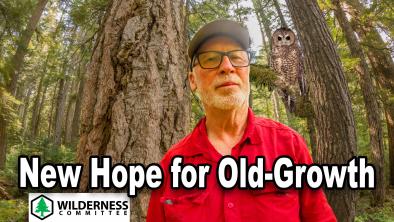Under the Owl's Wings - Wild Times

June 1st, 2010 - Read Joe Foy's Wild Times column in the Watershed Sentinel as he describes the ongoing battle to stop old-growth logging and save Canada's spotted owl - and much much more.
Southwest mainland BC is home to over two million people. You’d think that with all the people who live here, quiet wild places would be hard to find. But that’s not the case. Drag your butt up on to the mountain-top ridges above Chilliwack Lake, or bushwhack to the headwaters of Gold Creek in Golden Ears Park or any one of several thousand other places and it’s going to be you and the trees and critters. That’s a good thing – especially for the critters!
But the main threat to wildlife in the mountains hasn’t been crowds of weekend gawkers. It’s tended to be smaller groups, mostly riding bulldozers and packing chainsaws. The logging industry has left its deadly mark on local wildlife habitat. Far too many river valleys in southwest mainland BC have had a logging road punched to the back of the watershed, with its forest cloak ripped to tatters by clearcut logging.
In such a wild and rugged landscape as ours, its sometimes difficult to judge what effect all this logging has had on local wildlife populations. A common way to judge the health of wild country is to choose a wild animal who is particularly sensitive to habitat destruction. And by sensitive I don’t mean the critter’s feelings are hurt when its home is logged. I mean it dies out. We call such a wild animal an indicator species – which means that when its population starts to go down, many of the other wildlife in the area may be the next to hit the old extinction slide.
In the southwest mainland we have a superstar indicator species. We have the Northern spotted owl.
The health of the spotted owl reflects the health of its ancient forest habitat. In southwestern British Columbia, the only place the spotted owl is found in Canada, over 75 vertebrates (animals with a backbone) live in the same area as the spotted owl. Hiking in the ancient forests of southwestern BC, you can find Rocky Mountain tailed frogs, cougars, grizzly bears, cutthroat trout, fishers, white-tailed deer, hairy woodpeckers, black bears, flammulated owls, Northern goshawks, pileated woodpeckers, coho salmon and even the elusive marbled murrelet to name a few. However you will also find that 25% of these are endangered because of loss and fragmentation of their habitat by industrial logging.
So, how is Spotty the indicator owl doing?
Back in the 1880s when Vancouver was just getting started, there would have been about 500 pairs of spotted owls in the local forests. In 1990 provincial and federal biologists estimated that the spotted owl population had declined to a pitiful 10% remnant with only 50 pairs left. This should have been an extreme wake up call for our provincial government – but the logging of the region’s ancient forests continued.
In 2001 government biologists estimated that the spotted owl population had declined to only 25 breeding pairs. The chainsaws and bulldozers kept at it.
And now – finally in 2010, the International Year of Biodiversity – the BC government has placed some areas of southwest BC’s ancient forests off limits to the logging industry in order to try to recover the population of spotted owls.
You may wonder how many are left in the wild. There are six. This year the BC government plans to capture two of them for their captive breeding programme. And then there will be four left in the wild – for now.
Spotty has been indicating for some time now that we need to ban the logging of all ancient forests. If we don’t, we’ll soon reach the point where we are talking about the last four grizzlies, or the last four salmon or the last four murrelets, or the last four goshawks – the last four of everything.
If that happens, it will be a mighty lonely place I figure. We’ll be left to try to imagine back to a time when all creation lived together under the owl’s wings.
Joe Foy is Campaign Director for the Wilderness Committee, Canada’s largest citizen-funded membership-based wilderness preservation organization.


